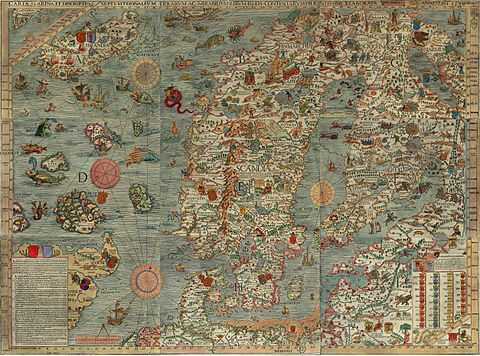Carta marina

The Carta marina (Latin "map of the sea" or "sea map"),[1] created by Olaus Magnus in the 16th century, is the earliest map of the Nordic countries that gives details and placenames. Only two earlier maps of Scandinavia are known, those of Jacob Ziegler and Claudius Clavus.
The map was created in Rome by the Swedish ecclesiastic Olaus Magnus (1490–1557), who arrived on a diplomatic visit for the Swedish government and stayed on, likely because his brother Johannes Magnus became involved in a religious feud with King Gustav I of Sweden.
The notes on the map in Latin were translated by Olaus into Italian and German. It is generally considered that the "A description of the Northern peoples" (Historia de gentibus septentrionalibus, Rome, 1555) is a much larger commentary on the map.
History
In production for 12 years, the first copies were printed in 1539 in Venice.
The map was printed from nine 55x40 cm woodcut blocks to produce a document that is 1.70 m wide by 1.25 m tall.
All of the map's copies passed out of public knowledge after 1574, and the map was largely forgotten – perhaps because only a few copies were printed and because Pope Paul III asserted a 10-year "copyright." It was later widely questioned whether the map had ever existed.[citation needed]
In 1886, Oscar Brenner found a copy at the Hof- und Staatsbibliothek[2] in Munich, Germany, where it currently resides. In 1961, another copy was found in Switzerland, brought to Sweden the following year by the Uppsala University Library; as of 2007 is stored at Carolina Rediviva.
A faithful reproduction of the map was printed in Rome by Antoine Lafréry in 1572.[3]
Notes
- ↑ Carta marina on the Wiktionary.
- ↑ Current location.
- ↑ Carta Marina, 1572 edition
References
| Wikimedia Commons has media related to Carta marina. |
- (Swedish)"Geografiens och de geografiska upptäckternas historia / Geography and The Geographical Voyager's history" (1899)
- "Carta marina et descriptio : the commentary by Olaus Magnus to Map of the Scandinavian countries 1539", Provisional ed. (1988)
- "Carta Marina, Lafreris edition 1572"- Antoine Lafréry's (1512 - 1577) edition from 1572, digitalized by the National Library of Sweden in Stockholm
External links
- CIPHER Project - Exploring the Carta Marina
- Carta Marina (Uppsala University Library)
- "University of Minnesota Carta Marina" - the original or Pope Paul III (1468–1549) map from 1539, in jpeg images. The site contains more information on early printing process.
- Carta Marina, Lafreris edition 1572 at the World Digital Library (Antoine Lafréry's (1512 - 1577) edition from 1572 digitized by the National Library of Sweden in Stockholm